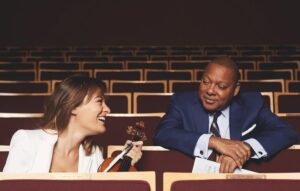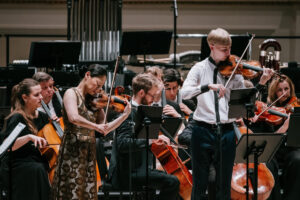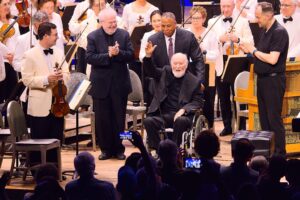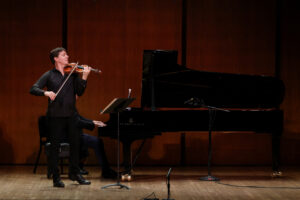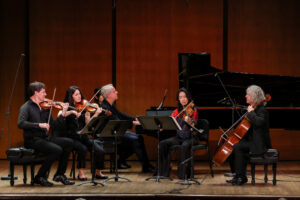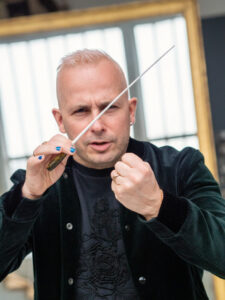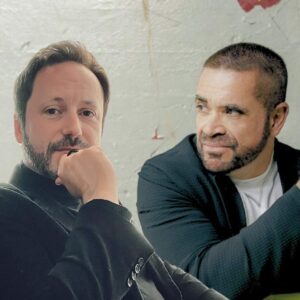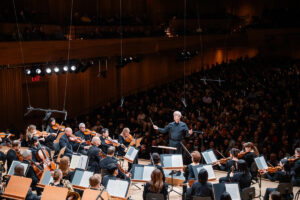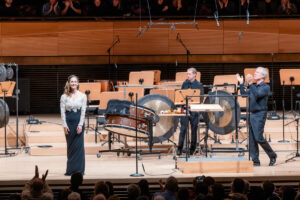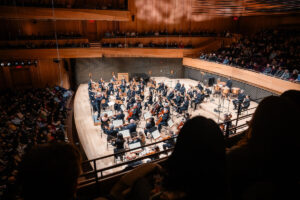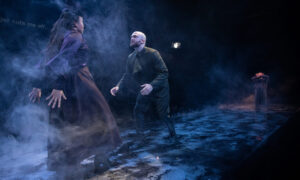Painful footsteps are behind me
Here you stand so clear and far
Through the willows all I see
is a lonely burning star
–Thor Lange, “Sun at Rest”
Cellist Kirstine Elise Pedersen and bassist Mathæus Bech, a.k.a. LuLo, came together through a shared fascination with the singular, often-misunderstood Danish composer Rued Langgaard (1893–1952). Their approach to his music is both reverent and daring. Rather than treating the scores as sacred artifacts, they dismantled them lovingly, listening closely to recordings, transcribing passages by ear, and distilling sprawling works—from piano pieces to string quartets and symphonies—down to a page or less of melody and harmony. From there, they rebuilt them intuitively, as if they were fragments of folk music handed down orally rather than concert works locked behind museum glass.
The resulting album is inseparable from its physical form: a book-object accompanied by archival photographs and artistic images by Bech, along with notes that gesture toward the times, places, and emotional climates that shaped Langgaard’s life.
Said life haunts the music at every turn. A prodigy who performed his first concert at 11 and saw his first symphony performed by the Berlin Philharmonic to great acclaim, Langgaard soon found himself at odds with the musical establishment. His eccentricity and refusal to remain stylistically obedient—shifting from late Romanticism into something more abrasive, prophetic, even anarchic—left him increasingly isolated. Colleagues mocked him; institutions ignored him. Out of seeming desperation, he wrote oblique instructions like “repeat for all eternity” or “repeat with a crescendo until either the piano or your fingers break.” Of the roughly 400 works he composed, only a tenth were performed during his lifetime, often at his own expense. Eventually, weary of his complaints, the cultural elite arranged for him to be quietly exiled to a post as a church organist at the far end of the country. Langgaard accepted, despite knowing full well the intention behind the offer. He died largely forgotten, his music surfacing again only in the present century, like a message in a bottle.
LuLo’s interpretations capture this sense of restless compression with the utmost attention to detail. The album opens in a state of delicate agitation with pieces like “Cowbells in the Pine Forest,” where fluttering textures suggest jangling metal or distant movement before a melody emerges with the pale light of rural dawn. This deeply illustrative quality recurs throughout the record, pastoral on the surface but threaded with unease.
Tensions between gratitude and suspicion run through original compositions like Bech’s “Thankful” and “Waltz for Rued,” the latter inspired by Langgaard’s Andante Religioso for violin and organ (BVN407). These pieces glisten briefly, like dew left as an offering, yet they never lose contact with an underlying darkness. Joy here is fragile, provisional, always shadowed by the knowledge of what followed.
The folk impulse comes into sharper focus on tracks such as “Swedish,” where droning textures give way to a melody both exuberant and tense. Gorgeous dissonances and a sense of forlorn joy suggest music shaped by communal memory rather than personal triumph. That same feeling carries into “Sun at Rest” (BVN 136). Originally for string quartet and soprano, this iteration features Kira Martini’s voice moving with gentle inevitability through a melancholy landscape without ever becoming merely bucolic.
Elsewhere, motion takes over. “God’s Will” is reduced from its originally massive scoring to a pulsing, cinematic drive that advances with locomotive persistence, while “Passing Train,” Pedersen’s response to the second movement of String Quartet No. 2 (BVN145), leans fully into programmatic imagery. Rhythm becomes destiny, propulsion its own kind of meaning. Even the cosmic unrest of “Music of the Spheres” (BVN 128), with its theological visions of Antichrist and salvation, feels grounded here, less apocalyptic spectacle than ceaseless spiritual pressure pushing through space and time.
Some of the album’s most revelatory moments arise through extreme condensation. LuLo’s reimagining of material from String Quartet No. 3 (BVN183) strips the work down to its nervous system, revealing a surprising jazz-inflected modernity. Elastic phrasing and rhythmic instability expose Langgaard not as an anachronism, but as a composer perpetually out of joint with his own era. Pieces like “Ixion” (from Symphony No. 11, BVN303) dance cautiously, never fully leaving the ground, their instability suggesting sandcastles built with full knowledge of the tide.
As the album darkens, disquiet gives way to exhaustion. “Eventually Mad” (BVN371) and “The Restless Wind” (BVN149) feel vast and elegiac, drifting like unanswered prayers. This sense of terminal weariness reaches its quiet apex in “Tired,” again featuring Martini, whose voice moves rhythmically through a landscape of ashen flowers. It is a song not just of rest from labor, but from life itself.
By the time The Restless draws to a close, the title feels less like a description of nervous energy or creative compulsion and more like a metaphysical condition. Langgaard’s life suggests what happens when faith, imagination, and sensitivity collide with institutional indifference, when vision outpaces comprehension. LuLo does not attempt to resolve this tension or redeem it with posthumous triumph. Instead, the musicians sit with it, listening carefully.
In doing so, the album poses a quiet but unsettling question: What does it mean to be heard, and when does listening finally arrive too late? We are given no answers, only the sense that music, even when ignored or misunderstood, continues to move forward, carried by those willing to approach it as something living. In that persistence lies both consolation and sorrow, as a lonely burning star glimpsed through the willows, still shining long after the footsteps have faded.

